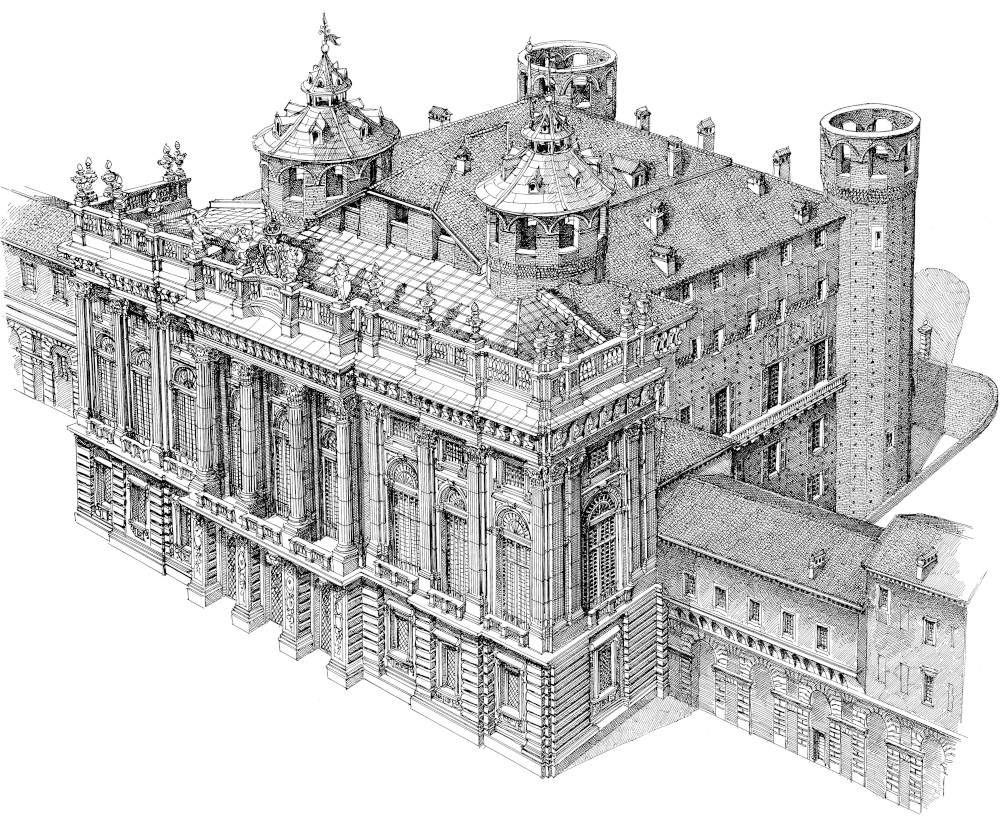Palazzo Madama-Turin’s Museo Civico d’Arte Antica (Museum of Ancient Art ) inaugurates, from September 21, 2022, a new exhibit in the Medieval Court, curated by Palazzo Madama in collaboration with the Francesco Corni Foundation. A visual narrative that welcomes visitors as they enter the museum, to tell the two thousand years of history of Palazzo Madama and Turin, from the Roman era to the 20th century. Set in the Medieval Court, where the architectural traces of this millennial evolution remain, the exhibition develops from some 30 plates created by the Modenese draftsman Francesco Corni: drawings that detail the main moments of the city’s growth and follow the building events of Palazzo Madama. They start from the foundation of Julia Augusta Taurinorum in the Augustan period, when the quadrangular layout of the city was set up based on the two main roads: the decumanus maxim us and the cardus maximus, which still characterizes it today. It was during that period that the four monumental city gates were built, including the decumanus gate on which the Achaia castle was to be built, later to be transformed into Palazzo Madama in the 18th century.
The route follows the evolution of the medieval city and the Phibellona gate that gradually replaced the decuman gate. With it, the castle is transformed: in the 14th century Filippo d’Acaia attaches two square towers to the Roman towers and makes the new terracotta facing of the inner courtyard; in the following century Ludovico d’Acaia enlarges the building plan by adding two more towers symmetrical to the Roman ones. The castle became a princely residence with bedrooms, a feast hall, a large kitchen, and a garden. In the 16th century, Emanuel Philibert of Savoy moved the capital of the Savoy duchy from Chambéry to Turin (1563) and began the fortification of the city with the creation of the citadel. The three successive enlargements completed the development of the capital city, almost tripling its size: with Charles Emmanuel I toward Porta Nuova (from 1619), with Charles Emmanuel II toward the Po (from 1673), and with Victor Amadeus II to the west, toward Porta Susina (from 1703). Tables of the extensions alternate with drawings of Palazzo Madama at the time of the two Madame Royales of Savoy, Christina of France and Marie Jeanne Baptiste of Savoy Nemours. Christina’s intervention led to the covering of the Medieval Court and the creation of a great hall on the second floor, now the Senate Hall. Maria Giovanna Battista, on the other hand, was responsible for renovating the first-floor apartment and commissioning Filippo Juvarra to build the monumental staircase and facade, a masterpiece of Baroque architecture (1718 - 1721). This was followed by territorial expansion from the 1840s in the Porta Nuova area, the San Salvario district and the Vanchiglia area, with the construction of the landmark building of the Mole Antonelliana. The halls of Palazzo Madama see the succession of public offices, private residences and major events. It is home to the Royal Picture Gallery, the Senate of the Kingdom, and the Astronomical Observatory. The Unification of Italy is declared here. Since 1864, restoration work by architect Alfredo D’Andrade has led the monument back to its medieval appearance.
The itinerary closes with the twentieth century and the arrival in 1934 of the Museo Civico d’Arte Antica in its new home in Palazzo Madama. Francesco Corni’s black ink drawings are based on a solid knowledge of historical, documentary and visual sources relating to the subjects depicted. Drawings that give visitors the opportunity to appreciate the most minute details and get a very concrete idea of how the city and palace looked in each historical period. The accompanying texts in the exhibition provide information about the history, its protagonists, construction techniques, and daily life of the time. The aim of the project is to restore to visitors’ sensibilities the essential role of Palazzo Madama in its being the beating heart of Turin, whose growth and development is reflected in the evolution of the city itself. A Palazzo Madama pivot of a short city system that sees, in just a few hundred meters, the development over the centuries of what has now become one of Europe’s great museum routes: from the Royal Church of San Lorenzo to Palazzo Chiablese, to the Duomo, to the Royal Palace with the Chapel of the Holy Shroud and its archaeological areas, the Sabauda Gallery, the Royal Armory and the Royal Library. But also the State Secretariats with the prefecture, the State Archives and Teatro Regio, the Cavallerizza Reale and the Cinema Museum, the Accademia Albertina and the National Library, Palazzo Carignano and the Academy of Sciences with the Egyptian Museum.
For info: www.palazzomadamatorino.it
Image: Francesco Corni, Palazzo Madama at the time of Marie Jeanne Baptiste of Savoy Nemours (Indian ink on tracing paper; 35 x 30 cm; Strambino, 1997).
 |
| Turin, a new exhibit chronicles the 2,000 years of the city and Palazzo Madama |
Warning: the translation into English of the original Italian article was created using automatic tools. We undertake to review all articles, but we do not guarantee the total absence of inaccuracies in the translation due to the program. You can find the original by clicking on the ITA button. If you find any mistake,please contact us.